L3Harris Technologies [LHX] said Monday the company has received a full-rate production order from the Marine Corps to deliver its new AN/PRC-165 Handheld-Video Data Link (HH-VDL) tactical radios.
The Marine Corps will serve as the first U.S. military branch to receive the AN-PRC-165 HH-VDLs, which are part of the company’s Falcon IV line of software-defined radios.

“The AN/PRC-165 provides Marines on the ground with full motion [intelligence, surveillance and reconnaissance] video and data in a secure, resilient, low-[size, weight and power] transceiver, with full frequency support and modernized Type 1 encryption enabling secure capabilities with the most advanced algorithms,” Bryant Henson, L3Harris’ president of tactical communications, said in a statement. “As we move to the future the AN/PRC-165 and all of our Falcon IV [software-defined radio] products allow for seamless feature and capability upgrades that will support current and next generation resilient waveforms.”
L3Harris noted the company first received a five-year, $130 million deal from the Air Force in 2018 to develop and deliver the HH-VDL capability.
At the time, the company said the HH-VDL radios “will replace existing incumbent ground ISR terminals operating at the tactical edge of the battlespace, providing increased capability in a more mobile solution.”
“The L3Harris Falcon IV AN/PRC-165 is a software defined radio (SDR) radio that securely transmits and receives full motion video and data with multiple manned and unmanned airborne and ground assets – improving the warfighter’s ability to conduct close air support as well as command and control,” the company wrote in a statement on the full-rate production order.
On Friday, L3Harris was also included along with Elbit Systems of America on the Army’s latest order for the Aviator’s Night Vision Imaging System III, also known as AN/AVS-6.
Both companies will continue to compete for orders under a new four-year, $92.4 million deal to deliver the latest version of AN/AVS-6 helmet-mounted, image-intensification device.